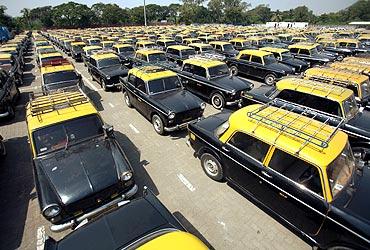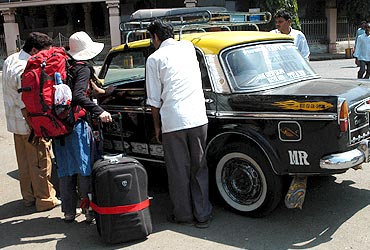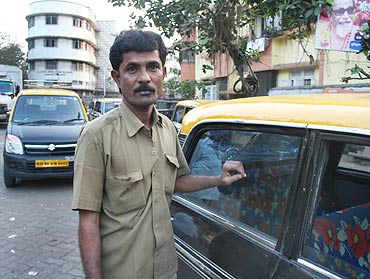These taxis have survived several attempts by the authorities to phase them out and have beaten back competition from swankier radio cabs.
Rediff.com takes a look at why Mumbai's kaali-peeli cabs now confront the double impact of commuter grievances and the authorities's proposed change of rules.
Do you find it difficult these days to hail a cab in Mumbai during peak hours?
Take a look at these numbers.
According to Mumbai Taximen's Union President A L Quadros, 60,338 taxis in 1997 had permits to cater to a population of 8 million.
In 2010, only 40,298 cabs have permits and Mumbai's population has shot up to 12.5 million.
"After the Bombay high court order in 2000 stipulating a deadline for the conversion from diesel to CNG, a significant number of taxis were not able to comply with the court's norms," says Quadros, "hence, their permits expired. The ratio of taxis to the number of people is very low."
Reportage: N Ganesh in Mumbai
'Even though people own cars, they still commute by taxis'
Image: A traveler to the city takes a taxiSo, in a city of 12.5 million people, only 32,000 to 35,000 cabs are actually in operation.
It is estimated that about 5 million people commute by cabs in Mumbai every day.
That means that for every 142 people, there is only one taxi.
Add to this fact that roughly 30 per cent of Mumbai's taxis are stationed at the city's airports.
"Finding a parking space in the city is so daunting that even though people own cars," says Quadros, "they prefer to commute by taxis."
Maharashtra Transport Commissioner Dinesh Jadhav says ideally, the ratio of taxis to commuters should be 1,000 taxis for 100,000 people.
So Mumbai needs as many as 125,000 taxis to reach this ideal ratio.
"During peak hours," says Jadhav, "people may find it difficult to get taxis in certain areas of south Mumbai. But within six months, the scenario will change as the fleet taxis will be augmented by 4,000, taking the total number of fleet taxis to 10,000."
Fleet taxi service hits yellow-black cabs
Image: Taxi drivers routinely turn down short distance fares"With the demand being very high," says Krishnan, "we commuters do not have a choice. The taxi drivers have a choice and will opt for routes that would fetch them more money. It is for the authorities to do something about the enormous deficiency in the micro transport system and address the issue."
The Meter Jam campaign, which urged Mumbaikars to boycott autorickshaws and taxis in Mumba for a day, provided a platform to the city's harried commuters to voice their grievances about the autos and cabs.
Since the number of permits has not increased since 1997, the introduction of fleet taxis -- Meru, Cool Cab and others -- further depletes the number of yellow and black cabs as the fleet companies buy out permits from existing permit holders.
'Govt wants to get rid of yellow-black cabs'
Image: The city's famed cabs may soon be extinctPhotographs: Uttam Ghosh/Rediff.com
"The government is keen on increasing the number of fleet taxis and wants eventually to get rid of all the yellow and black taxis," alleges Quadros, the Mumbai Taximen's Union president.
Alternative modes of transport like the Mumbai Metro may help to some extent, feels Meter Jam's Krishnan.
"There is no alternative to taxis or autos as they make up the most economical micro transport system," he says.
'Many aggrieved commuters'
Image: A cabbie takes a nap, not an uncommon sight in the cityFines of Rs 1.4 million, he adds, were recovered recently from taxi and auto rickshaw drivers based on commuter complaints.
"The amount recovered gives an idea of the quantum of aggrieved commuters, which is only the tip of the iceberg," says Shastry.
He laments the fact that there is little or no representation of commuters in the decision making process related to public transport.
"There are unions representing the interest of taxis and autos and then there is the administration, which doesn't make use of the public transport system," points out Shastry. "There has been never been any attempt by either the administration or the unions to include the people to share their views."






article